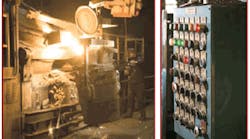Manufacturing has evolved significantly since the 1950s. Yet, the way that a task analysis is conducted has remained relatively stable since that time. The traditional method of observing and documenting the tasks, actions, and/or the mental processing performed by each employee is both time-consuming and dependent on the accuracy of the recorder.
The varieties of positions within any company, and the different ways in which people perform their job functions have required the use of a variety of additional methods for documenting procedures. However, in spite of the need for various documenting methods, depending on the complexity and/or type of job or position, the documentation process has remained extremely time consuming.
The economy has changed the needs of all manufacturing and service organizations around the world. They seek faster, easier, more economically efficient, and reliable means to pursue quality improvement, along with a multitude of other internal responsibilities. With these needs in mind, a significantly different approach to conducting a task analysis was developed, tested, and used in four manufacturing companies varying in both size and market sector.
The goal at the outset of this development project was to design a reliable method for conducting a task analysis that was easy to use, cost-effective, and would work regardless of the type of job, position, company, or organization.
Smith Foundry in Minneapolis was one of the manufacturers that agreed to work with the developer to test a new task analysis method, and a simplified five-step method for documenting procedures. These two new “tools” resulted in the documentation of its company-wide procedures in two days. Then, the “rough draft” of their procedure manual was reviewed, revised, and finalized within three months of the initial start date. Using conventional methods, the task analysis alone in a company like Smith Foundry, having approximately 100 people, could easily take from six months to a year to complete.
The use of these two new tools did, in fact, make it possible to reduce the task analysis process to days, rather than months or even years, regardless of the size or type of company. Additionally, the same method is used for all positions throughout the company.
All employees, up to and including the president of Smith Foundry, were oriented to, and involved in, the documentation process, and thus gained “ownership” in the project and final product. However, the task of completing this portion of their Procedure Manual was not the end of the entire project. To determine the reliability of the information gathered, internal audits had to be conducted.
Due to employees taking ownership in the initial project, a number of them volunteered for internal auditor training and actually participated in the internal audit. It was through this audit that the reliability and validity of the documented procedures were proven to be sound.
What would you think if I said: “Using these new tools, and spending just 30 minutes with your people, you’ll get the majority of your procedures documented. I don’t care if it’s 10 people or 500 people in the 30 minute session, you’ll get the same results”? Now, you have to realize that the complexities of some jobs will require more than 30 minutes to complete. But, everyone will know what’s required, and will be able to provide concise and accurate information within days of this first group session.
The documentation of procedures is an integral part of hiring, training, and quality improvement within any organization. In some form, the tasks performed in a company must be identified. Simply put, if we don’t know how employees do/ should do a particular job, how can we select personnel for it, train for it, or find innovative ways to improve that job?
This pilot test was an economical and time reduction “proving station” for this new task analysis method and the five-step method for documenting procedures. The results showed that these alternative tools are in fact cost-effective, with highly reliable results.
Because organizations must maintain cost and quality control, and function in a world marketplace, these same tools can aid in the pursuit of select quality standards requirements. For example, the ISO 9000: 2008 standards require, at minimum, control of your Quality Management System (QMS). However, according to the ISO document: ISO/TC 176/SC 2/N525 R2, Oct. 2008, the documentation of “work and/or test instructions” can both “add value to its QMS and demonstrate conformity”.
Considering the various applications for task analysis information, these two products could significantly impact the way that companies and organizations around the world conduct future projects requiring the documentation of their procedures.
| James Currey, author and developer, is the owner of Contemporary Business Services, which has been providing solutions for industry and educational institutions around the world since 1982. He holds graduate degrees from the University of Minnesota, where he has been an instructor, too. Contact him at [email protected], or visit www.easytaskanalysis.com. The author extends his gratitude to Smith Foundry for its participation in the pilot test. |












